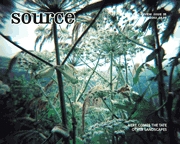EDITORIAL:
Issue 35 — Summer 2003
Issue 35 — Summer 2003
View Contents ▸
On the 6th June Tate Modern will open its bumper exhibition, Cruel and Tender, that sets out to clear away the problematic aspects of the Tate's relationship to the medium and start afresh with fewer inhibitions as to what is suitable for the gallery to exhibit. In 1994 Frances Morris, then responsible for acquisitions at the Tate, was interviewed by Creative Camera about their policy. She said that the Tate would hope to fulfil photographer's expectations when the new Bankside gallery opened. Emma Dexter has co-curated Cruel and Tender. Helen James interviews both Dexter and Morris to discover how they understand the institution's relationship to the medium, why they are showing documentary photography and what their plans are for the future.
Landscape is a cultural concept and images of the landscape have played an important part in the formation of both Irish and Welsh national identity. Justin Carville introduces Dan Shipsides' project Pioneers about the first generation of rock climbers in Ireland. Carville describes how the field clubs and amateur naturalists of the 1890s provide a precedent for this way of making the landscape knowable. Shipsides' work involves both annotated photographs and an audio CD which combine to tell the story of the first time certain classic climbs were achieved. This mixture of diagramatic abstraction and reminiscence provide an alternative way to represent this historically significant Irish landscape.
Paul Cabuts has returned to the more pragmatic use of photography employed by the builders of power lines in the 1920s. He contrasts the bright future promised by this project with the dominant image of the Welsh Valleys, that of redundant industry. By photographing contemporary powerlines he aims to rediscover some of the optimism of the original modernist project, only this time focusing on the individuality of these practical structures.
Andrea Liggins also engages with the conventions of landscape imagery. By relocating the viewer in relation to the landscape, often in a disorientating way, she aims to produce a more subjective and less proprietorial form of landscape.
In contrast to these strategies Alfredo D'Amato's approach to his subject suggests that the conventions of landscape and documentary photography are still available as a means to explore the world and other people's experience of it. His images of the daily lives of four families in south east Romania depict a harsh relationship to the landscape, far removed from the leisured middle class pursuits of climbers and amateur botanists.
— The Editors





